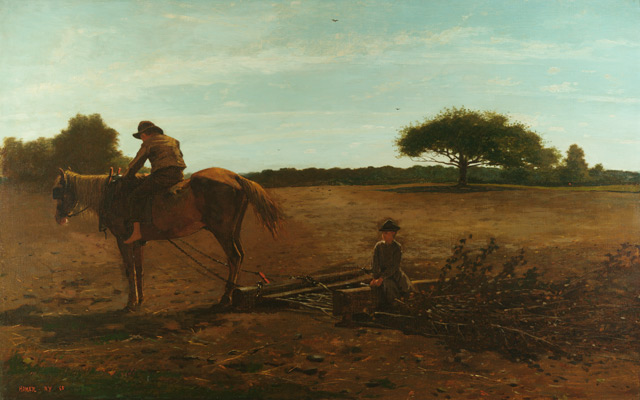Though it has been 150 years since the conclusion of the U.S. Civil War, the conflict and its legacy still have the power to evoke complicated emotions and scholarly debate. Then, as now, artists found in the war deeply complex subjects for visual expression—and some of those responses have a home in the Harvard Art Museums collections.
The museums are spotlighting Civil War–related works this spring with two events that are part of the Harvard Civil War Project. Inspired by the National Civil War Project, Harvard’s programming has been facilitated by the Office for the Arts in collaboration with ten Harvard-affiliated departments; it includes gallery talks, exhibitions, performances, lectures, seminars, and more—most of which are free and open to the public.
“There are so many ways to revisit the Civil War’s lasting legacy in our nation and to make new discoveries, both artistic and academic,” said Teil Silverstein, consulting project manager for the Office for the Arts. “This anniversary has been fertile ground for a wide range of initiatives at the university.”
The Harvard Art Museums’ first Civil War Project event, held in late February, focused on works by 19th-century American artist Winslow Homer. Ethan Lasser, interim head of the Division of European and American Art, and the Margaret S. Winthrop Associate Curator of American Art, gave a gallery talk about two significant Homer paintings on view, Pitching Quoits and The Brush Harrow.
Both created in 1865, the works depict two very different time periods. Pitching Quoits portrays a game of horseshoes in the camp of the Fifth New York Infantry, a Union regiment from New York, whose flamboyant Zouave attire was inspired by Algerian mercenaries. Many of these soldiers were massacred in battle in Manassas, Virginia, in 1862, giving the painting a darker undertone than its appearance initially suggests. In The Brush Harrow, Homer employs a subdued color palette to depict young boys working in a field. The artist intended viewers to pick up on what is missing from the painting, Lasser said during his talk. “What’s not here are the men who do the work: the fathers, the brothers, who haven’t come home from the war.”
For the museums’ second event, Lasser and Penley Knipe, the Philip and Lynn Straus Conservator of Works of Art on Paper, will hold an Up-Close Seminar titled “The Civil War in American Art,” on April 10. The session, to be held in the Art Study Center, will closely examine a range of objects from the museums’ collections, including Homer’s engravings from the war for Harper’s Weekly and (Alexander) Gardner’s Photographic Sketch Book of the War.
Contemporary work will be considered as well, with a look at artist Kara Walker’s 2005 Pictorial History of the Civil War, which features provocative silhouettes screenprinted atop enlarged lithographic reproductions from Harper’s Pictorial History of the Civil War (1866 and 1868).
Presented by the Office for the Arts Public Art Program, contemporary artist Brian Knep’s site-specific installation Deep Wounds (2006), which explores reconciliation through a focus on Harvard alumni who died in the Civil War, also will be on view in Memorial Hall from April 4 through May 7. This innovative work, which uses computer-generated projection technology, makes an intriguing complement to Harvard’s rich collection of visual responses to the war.
While the works at the center of these events recall the past in diverse ways, it’s not difficult to understand their relevance to modern-day topics such as civil conflict, loss, and healing. In this way, the works of art are likely to prompt further discussion and discoveries, fulfilling a key goal of the Harvard Civil War Project.





